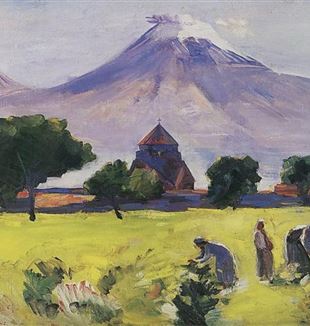
The mystery uses the unknown to attract
A shared Armenian evening with friends in a small town in Luxembourg. Armenian dishes, art and music, to re-discover the "mysterious attractiveness of the beauty and the truth through the unknown."There is an unknown smell in the house, Hubert is frying liver for the tjvjik, Martin's nine loaves of matnakash are just out of the oven, Simon's quince soup is simmering again and Maria is putting the lobiov paschtet in the fridge until later...
The first guests arrive at our place in Bourglinster, each carrying a different savoury or sweet Armenian dish and trying hard to remember and pronounce the name of it as they put it down. A foreign Armenian life flares up among 30 non-Armenians of different ages, origins and backgrounds, most of whom are meeting each other for the first time.
Simon already had an old, somewhat dormant sympathy for the Armenians when he was at school about 30 years ago. It was above all for a people that has survived for more than two millennia. "Because it seems to know what it is and wants to remain itself. Above all – but not only – through the encounter with Christ. That touches me tremendously. Again and again. And now this sympathy has been rekindled by the drama of Nagorno-Karabakh and has infected first my wife, and then my teenage children – perhaps even more than it did me," Simon said when welcoming the guests. "And then, as happens wonderfully and yet often, this sympathy was also rekindled in our friends Maria and Martin." This led to the joint proposal to invite to an Armenian evening, to which cultural contributions and Armenian culinary souvenirs were the response.
A deep dive into the foreign but fascinating culture and the unfortunately ever-present history of this people – enriched by Ludwig's contribution about the life and work of the artist Martiros Saryan, Martin's historically and geopolitically profound impulse as well as the contribution of three teenagers about the life and movingly beautiful legacy of Armenia's "father of music" Komitas Vardapet (we heard the choral song "De Yel" as well as "Al aylughs" played by the trio Sergey Khachatryan, Narek Hakhnazaryan and Lusine Khachatryan) with a concluding live violin duet of an Armenian folk dance – gave those present deep, precious encounters. The gratitude we felt ourselves as well as the striking thanks we received in the days afterwards are signs of this.
A music teacher wrote: "We are completely taken by this sympathy for the Armenian people. Until now I only knew Khachaturian. After the lecture on the history of his country, which your friend delivered so passionately, I look at his music from a completely different point of view." Another person described it as a "bonus" in the morning that she was "allowed to re-dream the extraordinarily enriching evening at night." What impressed her most was "the beauty and affection of some people". The content of the presentations showed her "new ways of thinking, also with regard to the current situation". It is "far too rare to be able to participate in this way and in these kinds of encounters, but I would like to experience more of them.
Thus, the contagious flaring up of the dramatic history of the Armenian people developed into a precious missionary gesture for all of us. Our heart could expand. Where it had lost its path, it could find its way home again. This happened as eyes, palate and ears were allowed to encounter the mysterious attractiveness of the beauty and the truth through the unknown.
Katja, Bourglinster, Luxembourg